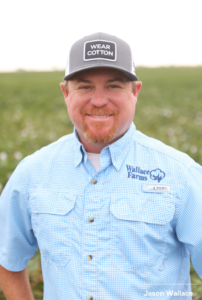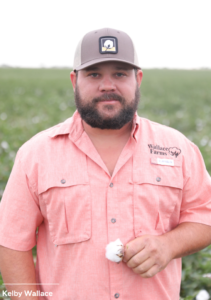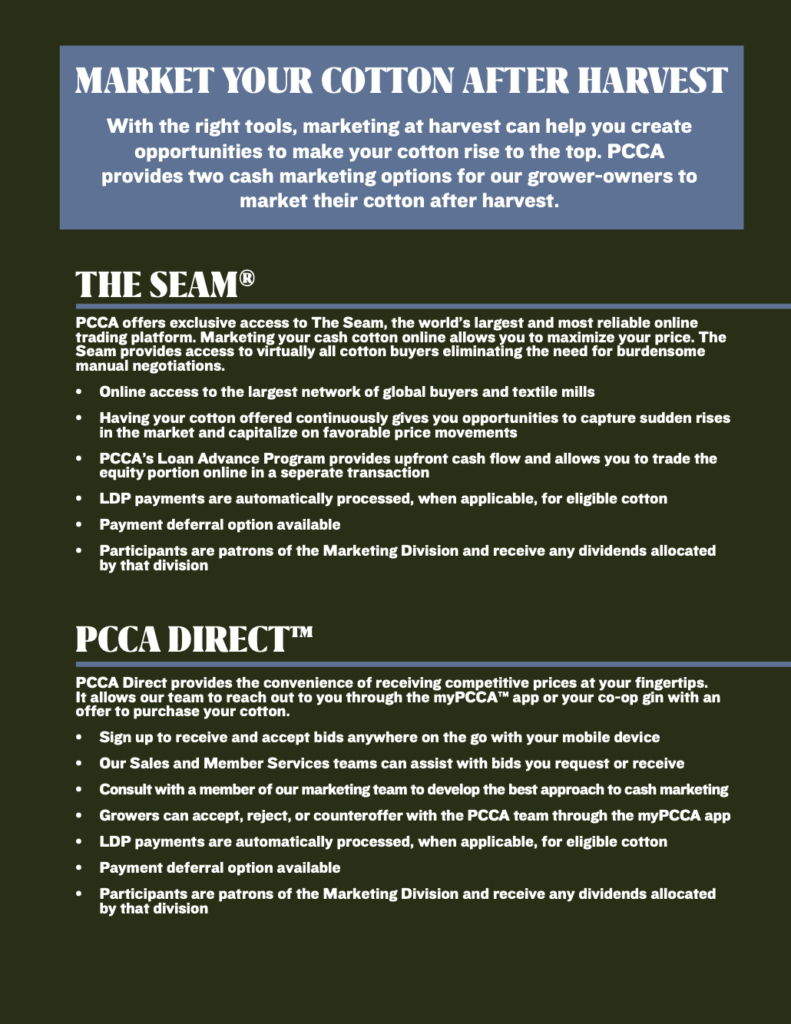by Jayci Bishop
“You have to evolve as a farmer, and if you don’t learn something new every single year, then you are not out here doing any good,” Jason Wallace said. “You need to learn something every single year and just put that in your toolbox. You don’t have to do the same thing every year, but you need to have a toolbox there where you store all those memories and everything that happened in the last however long you’ve been farming.”
The Wallace Brothers’ toolbox is full of experience, hard work, and lessons from themselves and the generations that came before them. Jason and Kelby Wallace are continually adapting and looking toward the future of their farming operation. “That’s the way we have always done it” is not a phrase they often use. Their fourth-generation family operation evolved from what it looked like five or 10 years ago and is wildly different from when their dad, uncle, and grandfather were farming. Today they work together to farm cotton, wheat, rye, and alfalfa in Blair, Oklahoma.
“Farming has changed a lot in the last 10 years here,” Jason explained. “We used to be conventional till, furrow water irrigation with some pivot and a little bit of drip. Now we have changed that to trying to run everything through cover, trying to build up the soil.”
Over the past 10 years, the Wallace Brothers have improved soil health by switching to air-injected dry fertilizer rather than solely relying on anhydrous ammonia. The changes in practice have paid off through better yields. Incorporating no-till practices into their operation provides other benefits besides more pounds. Before no-till, they struggled to control the sand blowing after a storm to protect their crop from destruction.
 “We have a lot of sandy, highly erodible soil around here,” Jason said. “So when we start putting that cover crop in there and building that organic matter back up in that soil, the wind could be blowing 40-50 miles per hour out here, and I am confident my cotton is protected down there because it’s down in its little shield with the stubble. That’s just one aspect of it. Another big one is increased weed suppression.”
“We have a lot of sandy, highly erodible soil around here,” Jason said. “So when we start putting that cover crop in there and building that organic matter back up in that soil, the wind could be blowing 40-50 miles per hour out here, and I am confident my cotton is protected down there because it’s down in its little shield with the stubble. That’s just one aspect of it. Another big one is increased weed suppression.”
Soil fertility and profitability can go hand in hand. The Wallace brothers also have implemented variable rate applications since 2010 to help improve their bottom line. “We have actually been seeing it is overall, across the board, acre-per-acre, cheaper than if we were just going out there and throwing 200 pounds of this and 200 pounds of that,” Kelby said. “That has been cost-efficient for us big time. Not working the ground as much anymore, tractors and plows, and not burning that diesel every day. That saves a lot of wear and tear on our tractors and equipment. We only go across our ground three times on our irrigated and when we are spraying in the summer, so that is saving us a lot.”
Their dedication earned them the Stoneville Legacy Club Award for irrigated and dryland cotton for the Southwest district last year, as well as a place in the FiberMax Cotton’s One Ton Club. As growers in the Lugert-Altus Irrigation District, water management has been a big focus for them in recent years.
“Water has become a big issue,” Jason said. “How to conserve it and use less inches per year, so we have some for next year or vice versa. The way things are going, water is becoming more and more of an issue. If we can figure out how to make bigger yields off of lower inches of water applied per year – that’s a win for everybody in this whole area down here.”
Not only do Jason and Kelby work to increase efficiencies on the farm, but they also try to minimize expenses where ever possible to mitigate high input costs. They both agreed that rising production costs are one of the biggest challenges farmers face today.
“The input costs are a challenge just on anything,” Kelby said. “It seems like you can’t even buy a bolt for a drill now that is less than $20. Just probably the costs – and you have to be careful on what you spend and how your crop looks and what you are going to make because a guy could go backward really fast if he did not keep up on it.”
“Today, it’s all about that bottom dollar, and it’s tougher and tougher. With higher yields, you need a decent price still, and it’s tough to make it pencil out at the end of the day with rising input costs,” Jason said. “Fertilizer and diesel are through the roof this year. That’s going to play a big role in what people do. But fertilizer is one of those things that we don’t ever back off on that. If we are going to cut corners somewhere, it’s not going to be on the fertility side or the soil health side; it’s going to be somewhere else. So you may not need to buy that new tractor this year. Let’s run the old ones and let’s dump our money into our farm.”
Supply chain issues are another hurdle growers are facing in today’s economy.
“You can go down to our local John Deere dealership right now and you cannot buy anything you want as far as new product,” Jason explained. “You are having to order one to two years in advance if you want a sprayer, a shredder, or a tractor. The availability of equipment has really suffered, and so has the cost of them. In the last 10 years, these used trac- tors have gone up maybe 300% and that is making it really, really tough. You’re still making three-bale cotton and selling it for 80 cents like you were four and five years ago, but yet your tractor went from being $200 thousand to $400 thousand. That’s going to cause some issues.”
Good farm management extends beyond the farm. According to Jason, a lot of business, financing, and planning go into a farming operation.
“You learn from being a kid to actually being a farm manager on your own how much business is involved in it,” Jason said. “You’re not just out there kicking dirt clods all the time. You’ve got to be in town, you’ve got to be at the FSA office, you’ve got to be working. Cotton Incorporated and PCCA have been great for the young farmers in the area, keeping us up to date on a lot of what’s going on. Jeremy Gifford with PCCA has probably been one of my best assets on the marketing side. We’ve really done well the last 10 years on the marketing side of things, promoting our cotton and getting it sold for the best prices we can get.”
The Wallace brothers have historically marketed their cotton on The Seam®. However, they have recently added a new marketing option from PCCA to sell their crop.
“We have sold all of our cotton pretty much in the last two years to PCCA Direct,” Jason said. “That was kind of a new thing a few years ago. I always just sold ours on The Seam. That’s just what we’ve always done. We weren’t ever really marketing pool guys. I feel like we had different options there and I felt better about marketing our own cotton on The Seam with Jeremy’s help. We’ve done that and it’s been great for us. Then a few years ago PCCA came out with the direct bid program and they contacted Humphreys Co-op, which is where we take all of our cotton. They felt comfort- able enough to kind of test the waters with us and throw some bids at us personally and we did that and I felt really comfortable with it. The last two years now, we probably sold at least 95% of our cotton to PCCA Direct. It’s been a really easy process.”
Whether it be marketing or agronomy decisions, one common factor is required for a successful farm – hard work. Both Jason and Kelby are trying to instill this trait in the next generation of their family.
“Definitely hard work. Nothing is going to be handed to you free in life,” Jason said. “The other deal is try and live outside of being comfortable. Nothing great has probably happened in your life if you weren’t a little uncomfortable. You’ve got to be willing to change things. Reach out a little bit.”
Working hard is for much more than the bottom dollar; it is for the future of their farm and family. Jason and his wife, Lacee, have two children: Ava (10) and Wager (7). Kelby and his wife Macie have two boys, Hagen (7) and Braxon (5), and they hope to pass on the family tradition one day.
“I would like to get one day where if our kids did want to farm, that I would be able to help them out where they wouldn’t have to start from scratch,” Kelby said. “The way the world works today, I couldn’t start from scratch right now even knowing what I do. So we are trying to pick up more ground, what ground we own or buy ground. Hopefully one day if they do want to farm they’ll have the option to do that.”
Two brothers working alongside each other day-in and day-out can be both rewarding and challenging. For the Wallace brothers, it is all about balance.
“We kind of balance each other out,” Kelby said. “I hear about a lot of people that farm together and they are together every day and they struggle and fight. My brother and I fight all the time but it’s just over something – whether he thinks it’s not planting deep enough, too shallow, and I’m adjusting it. We get along really good.”
“Me and my brother are nearly complete opposites, most people would say,” Jason said. “It’s kind of funny. We bring different aspects to the table and that makes it work really well for us. Another thing I enjoy is being around my nephews. He has two boys also. My son and his boy are three weeks apart, so they’re like twins. It’s just great to have family surrounding you in business, especially on years like this when times are tough and it’s hard and we haven’t had any rain. You need that family support to keep everybody going as a whole. So being able to farm with my brother and family the way we have for four generations now means a lot.”
Family, lessons, and experience are all tools for a successful farming operation. The Wallace brothers remain focused on what is important and continually plan for the future. The motto on their farm is, “A good end to a crop a year from now starts today.”


